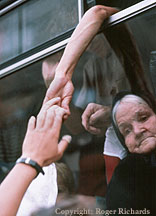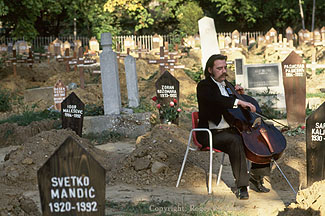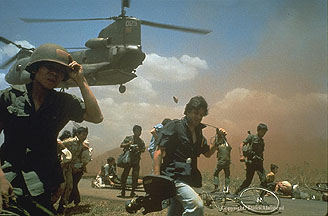With the advent of the book "Requiem", edited by Horst Faas and Tim Page, and the corresponding show at the Newseum in Arlington, Virginia, has come a new focus and awareness of that special breed of photojournalist, the War Photographer. Photojournalists are warriors who shoot with cameras instead of guns. Like normal soldiers, they face fear, fatigue and danger. As the legendary photographer Robert Capa once said, "If your pictures aren't good enough, it's because you aren't close enough." These brave men and women live and die by these words; because like normal soldiers, they can be shot and killed, or annihilated by a land mine. Neither of the men interviewed for this story liked the label "War Photographer". It spoke to them of blood-lusting carrion, heartless and cold. They winced, because their hearts bled at what they saw, and they fought back with burning passion and courageous spirit. While "Requiem" honored those men and women
who gave their lives to bring images reflecting the extremes of human cruelty
and courage home to Americans, this article honors two of the men who came
back, their spirits marked by battle, to carry forward the field of photojournalism
into the Twenty-First Century.
Long and wiry, David Burnett, 51, approaches across the parking lot at Starbucks in McLean, Virginia and sits down at the table. He is like a thin blue line of smoke, a subtle current of electricity, with sharp almost delicately boned features, and piercing grey-blue eyes that peer out from under a shock of unruly grey hair. There is a surprising sense of heightened sensitivity about this man that makes him seem more naturally placed in a monastery or the halls of academia than in the erupting chaos of a battlefield; but he was there, and he is one of the best. In 1970, David Burnett bought a ticket to Saigon for $512, stopping off in Hong Kong to buy a camera. With him, he carried letters from LIFE and TIME magazines, promises to buy pictures; necessary passports for a free-lance journalist to be accredited by the Army and let into the action. He was 24. From 1970 through 1972, he lived in Saigon out of a dingy little hotel room with rattan furniture and sisal rugs now ironically reminiscent of Pier1 Imports and The Pottery Barn. But this was no designer facsimile. This was real romantic adventure. There was a story to be told. "I see myself as a recorder of history," he said modestly, "sort of a visual historian." Many of his pictures capture scenes of everyday life in Vietnam, soldiers wearing headbands and love-beads, playing guitars in uneasy repose until the war would reconvene and death rudely interrupt. "For both the soldiers and the photographers," he said, "there were many hours of boredom, followed by moments of sheer terror." The photographer imprints his soul as well as the image he is photographing with his eye. To look through David Burnett's eyes is to capture images of iconic irony and translucent beauty amidst the mind-rending horrors of war. A feeling of subtlety permeates his work and draws you in, so that you cannot look away. His work has received numerous awards, including Photographer Of The Year, awarded by the National Press Photography Association in 1980, for his coverage of the Cambodian refugees; the Vietnamese "boat people"; and the revolution in Iran. After LIFE magazine folded in 1972, David Burnett worked as a free-lance photojournalist for the Gamma Liason Agency, started by legendary War Photographer Giles Caron, before starting his own agency in 1976 called Contact, with partner Robert Pledge. The agency continues to thrive today, with offices in both New York, and Paris. When asked what drew him into the world of photography as a teenager in Salt Lake City back in the early 1960's, David Burnett smiled, "the magic of the medium," he said softly, "the private moment of being alone in a darkroom and seeing the picture develop....it is still magic for me....." And with that, this most humble and private of men got up and left for the airport. A story waited to be told in L.A. "Photojournalism is not an art, but the best photojournalists are artists." Roger Richards, 36, leans across the table of Tivoli's Pastry shop in Rosslyn, Virginia. The passion and intensity of his conviction are as unmistakable and omnipresent in his personality, as they are in his work. Born in Jamaica, his obsession to tell stories with photography was ignited and encouraged when he met David Burnett, who was shooting a story about the island of Jamaica in 1982. Since then, Roger Richards has covered conflicts in Nicaragua, El Salvador, Columbia, Haiti and Bosnia. His coverage of the urban drug wars on our own streets, in Broward County, Florida for the Miami Herald's Tropic Magazine, earned him a Pulitzer prize nomination. His photographs have appeared in hundreds of magazines around the world during his work for the prestigious photographic agency, Gamma Liason International. He currently works as a staff photojournalist for the Washington Times. If the hallmark of David Burnett's work is the zen of finding the iconic in the subtle and even mundane aspects of a soldier's daily life, the work of Roger Richards hits you hard in the gut with it's heart wrenching depictions of humanity, both his own, and that of his subjects. 
Bosnian refugees cling to each other, 1992. Photographs taken of Roger Richards during the siege of Sarajevo reflect a man of great passion, whose heart has been turned into a fire of philosophical outrage at the atrocities that he sees perpetuated around him on a daily basis. "I did not choose to follow the 'bang-bang' of the war, but rather, to focus on the effect of the war on civilians, the men women and children of Sarajevo....I am very uncomfortable with the label "War Photographer"....I am a photojournalist. I have chosen to find my subjects in war, because in war, you have the greatest extremes of human experience and human behavior.... War brings out the best and the worst in people; the most heroic, and the most sadistic. It is black and white.....there is no grey." There are so many of Roger Richard's pictures of Sarajevo that stay on in the mind and refuse to leave, such as the image of Vedren Smajlovic ( pronounced, Smile-oh-vitch). Vedren was a cellist for the Orchestra of Sarajevo, who's brother was killed in the first of the massacres in may of 1992. A line of people were waiting for bread outside a bakery shop. Suddenly, two Serbian shells found their target, annihilating 22 people in a senseless act of destruction. For 22 days, during some of the worst shelling and sniper fire of the war, Vedren Smajlovic returned to the same spot where his brother died, set up a chair, and began to play Albinoni's Adagio for strings.
When this vigil had ended, he would go to the infamous "Lion Cemetery", infamous, because of the snipers who would lurk there and pick off civilians as they came to bury or mourn their dead. In an act of fearless defiance bordering on madness, Mr. Smajlovic, beautifully dressed, braved sniper fire, to play for the dead, as though he could reach them; as though he could comfort them. Only 150 yards away, the city morgue groaned with an overflow of bodies, many of them civilian victims of the war. "What can I say?" Roger Richards shrugged miserably, "Nobody loves war...especially not photojournalists....Maybe they hate it worst of all......" Going through the "Requiem" exhibit with Roger Richards, one got the sense that he felt like he did not belong in the company of the men and women whose works were represented, because he had survived. "Why me?" he mused aloud, like the sole survivor of a plane crash. "I have to tell myself that maybe God has a plan, that there are more things for me to do that I cannot know right now, and that that is the reason I was allowed to live when so many others died..... I did this work for 10 years, from the ages of 24 to 34......It really amazes me sometimes....I never thought I'd live to see 30....." Such is the effect of war on the souls of these men. They are strong, for they all chose to enter this arena of Mars; but they are all marked by what they have seen, and it is the stuff of nightmares. The lure of battle is true however, and a complex kind of addiction takes place. The drug is a potent cocktail of action, adventure, life and death. It is not easy to set aside a life of pure adrenaline. The safety of normal life can seem dangerously pale in comparison. As Roger Richards described so well, " When you're not there, sometimes all you can think of is going back, but then when you are there, all you can think of is getting out alive." Regardless of the messenger, one is caught again and again by the images of children in war, of old eyes in young faces that have seen too much pain to retain the innocence of childhood. Equally moving, is their resilience. Whether from David Burnett covering Vietnam in the 1960's, or Roger Richards, chronicling Sarajevo in the 1990's, one is struck and amazed by orphans banded together, smiling broadly for the camera, or running joyfully through a summer thunderstorm. In an atmosphere that permanently devastates
many adults psychologically, children are some of the most helpless victims,
and the hardiest survivors of war. Their spirits come through these photographs,
like blades of grass bursting through suffocating concrete They are images
of the living spirit of mankind; hope that there will be life after the
war.
"Imagine if Henry Luce had had the world wide web when he was putting together LIFE magazine back in the 1930's........"Larger than life, Dirck Halstead commands his outpost of digital imagery from his offices at TIME magazine in Washington, D.C. His photographs reflect a powerfully visceral eye for dramatic impact, that is almost cinematic in its scope. It is no surprise that his pictures have graced the cover of TIME magazine a record 48 times, more than any other photographer. Dirck Halstead is pure Hollywood, sitting in an office crammed with computer equipment, VCR's, digital cameras, tapes and film. Two desks are piled high with papers. The walls are covered with pictures: Dirck, the man's man, hanging out with the guys; Dirck, leaning back against a sporty red car in Havana; Dirck, the photojournalist as cowboy, frontiersman and movie star, holding his camera cocked on his shoulder in a pose that recalls Rambo with his rocket-launcher. A weathered combat helmet with the letters U.P.I. perches on top of a video monitor, a proud reminder of the days when he was U.P.I's bureau chief in Saigon, covering the Vietnam War in 1965. In 1975, Mr. Halstead was awarded the Robert Capa Gold Medal by the Overseas Press Club for his courageous coverage of the fall of Saigon, the battle which was to mark the final act of that war. Like the legendary Robert Capa who captured his youthful imagination in Westchester, New York, he is a maverick, and his own creation. And he's not done yet. Above his desk is a sign that reads, "I Am Only Interested In Long Term Performance." In 1994, he helped to found Video News International, which was recently acquired by the New York Times Company. Dirck Halstead, Senior White House photographer for TIME magazine, is now spearheading the evolution of photojournalism from a static medium dependent on paper-printed vehicles, into a multi-disciplinary, multi-media hybrid that incorporates the elements of print, radio, and visual journalism. Streamed through the digital universe of the world wide web, another dimension emerges from the information presented, the presence, and voice of the photojournalist. Just as he was there with the Marines on "China Beach" at Denang as the first shots rang out in the Vietnam war; and with the Marine Helicopters in the final hours of the battle for Saigon, Dirck Halstead wants to be on the frontier of the technological revolution that will redefine the future of photojournalism. "We want to be the bridge for photojournalism going into the 21st Century at a time when it desperately needs it.........." "Unlike old models of journalistic delivery systems, the world wide web is interactive, creating a circuit between the journalist and their audience.... the audience now becomes a participant, interacting with and potentially influencing the journalist, even as they are influencing and enlightening them..." Framed in the raw glare of his computer screen, Dirck Halstead leans forward, "The future model of photojournalism is no longer unidimentional.....it is dynamic.... the potentials of the new technologies have only just begun to be explored..." |



